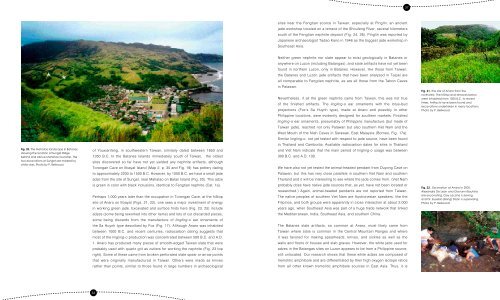Jade and the Philippines
Jade and the Philippines
Jade and the Philippines
Create successful ePaper yourself
Turn your PDF publications into a flip-book with our unique Google optimized e-Paper software.
Fig. 20. The Mahatao l<strong>and</strong>scape in Batanes,<br />
showing <strong>the</strong> location of Sunget Ridge<br />
behind <strong>and</strong> above Mahatao township. The<br />
two excavations at Sunget are marked by<br />
white stars. Photo by P. Bellwood<br />
of Youxianfang, in southwestern Taiwan, similarly dated between 1850 <strong>and</strong><br />
1350 B.C. In <strong>the</strong> Batanes Isl<strong>and</strong>s immediately south of Taiwan, <strong>the</strong> oldest<br />
sites discovered so far have not yet yielded any nephrite artifacts, although<br />
Torongan Cave on Itbayat Isl<strong>and</strong> (Map 2, p. 35 <strong>and</strong> Fig. 19) has pottery dating<br />
to approximately 2200 to 1500 B.C. However, by 1000 B.C. we have a small jade<br />
adze from <strong>the</strong> site of Sunget, near Mahatao on Batan Isl<strong>and</strong> (Fig. 20). This adze<br />
is green in color with black inclusions, identical to Fengtian nephrite (Cat. 1a).<br />
Perhaps 1,000 years later than <strong>the</strong> occupation in Torongan Cave, at <strong>the</strong> hilltop<br />
site of Anaro on Itbayat (Figs. 21, 22), one sees a major investment of energy<br />
in working green jade. Excavated <strong>and</strong> surface finds here (Fig. 23, 25) include<br />
adzes (some being reworked into o<strong>the</strong>r items) <strong>and</strong> lots of cut discarded pieces,<br />
some being discards from <strong>the</strong> manufacture of lingling-o ear ornaments of<br />
<strong>the</strong> Sa Huynh type described by Fox (Fig. 17). Although Anaro was inhabited<br />
between 1000 B.C. <strong>and</strong> recent centuries, radiocarbon dating suggests that<br />
most of <strong>the</strong> lingling-o production was concentrated between 500 B.C. <strong>and</strong> A.D.<br />
1. Anaro has produced many pieces of smooth-edged Taiwan slate that were<br />
probably used with quartz grit as cutters for working <strong>the</strong> nephrite (Fig. 23 top<br />
right). Some of <strong>the</strong>se came from broken perforated slate spear or arrow points<br />
that were originally manufactured in Taiwan. O<strong>the</strong>rs were made as knives<br />
ra<strong>the</strong>r than points, similar to those found in large numbers in archaeological<br />
36<br />
sites near <strong>the</strong> Fengtian source in Taiwan, especially at Pinglin, an ancient<br />
jade workshop located on a terrace of <strong>the</strong> Shoufeng River, several kilometers<br />
south of <strong>the</strong> Fengtian nephrite deposit (Fig. 24, 26). Pinglin was reported by<br />
Japanese archaeologist Tadao Kano in 1946 as <strong>the</strong> biggest jade workshop in<br />
Sou<strong>the</strong>ast Asia.<br />
Nei<strong>the</strong>r green nephrite nor slate appear to exist geologically in Batanes or<br />
anywhere on Luzon (including Batangas), <strong>and</strong> slate artifacts have not yet been<br />
found in nor<strong>the</strong>rn Luzon, only in Batanes. However, like those from Taiwan,<br />
<strong>the</strong> Batanes <strong>and</strong> Luzon jade artifacts that have been analyzed in Taipei are<br />
all comparable to Fengtian nephrite, as are all those from <strong>the</strong> Tabon Caves<br />
in Palawan.<br />
Never<strong>the</strong>less, if all <strong>the</strong> green nephrite came from Taiwan, this was not true<br />
of <strong>the</strong> finished artifacts. The lingling-o ear ornaments with <strong>the</strong> lotus-bud<br />
projections (Fox’s Sa Huynh type), made at Anaro <strong>and</strong> possibly in o<strong>the</strong>r<br />
Philippine locations, were evidently designed for sou<strong>the</strong>rn markets. Finished<br />
lingling-o ear ornaments, presumably of Philippine manufacture (but made of<br />
Taiwan jade), reached not only Palawan but also sou<strong>the</strong>rn Viet Nam <strong>and</strong> <strong>the</strong><br />
West Mouth of <strong>the</strong> Niah Caves in Sarawak, East Malaysia (Borneo, Fig. 17a).<br />
Similar lingling-o, not yet tested with respect to jade source, have been found<br />
in Thail<strong>and</strong> <strong>and</strong> Cambodia. Available radiocarbon dates for sites in Thail<strong>and</strong><br />
<strong>and</strong> Viet Nam indicate that <strong>the</strong> main period of lingling-o usage was between<br />
300 B.C. <strong>and</strong> A.D. 100.<br />
We have also not yet tested <strong>the</strong> animal-headed pendant from Duyong Cave on<br />
Palawan, but this has very close parallels in sou<strong>the</strong>rn Viet Nam <strong>and</strong> sou<strong>the</strong>rn<br />
Thail<strong>and</strong> <strong>and</strong> it will be interesting to see where <strong>the</strong> jade comes from. (Viet Nam<br />
probably does have native jade sources that, as yet, have not been located or<br />
researched.) Again, animal-headed pendants are not reported from Taiwan.<br />
The native peoples of sou<strong>the</strong>rn Viet Nam are Austronesian speakers, like <strong>the</strong><br />
Filipinos, <strong>and</strong> both groups were apparently in close interaction at about 2,000<br />
years ago, when Sou<strong>the</strong>ast Asia was part of a huge trade network that linked<br />
<strong>the</strong> Mediterranean, India, Sou<strong>the</strong>ast Asia, <strong>and</strong> sou<strong>the</strong>rn China.<br />
The Batanes slate artifacts, so common at Anaro, most likely came from<br />
Taiwan where slate is common in <strong>the</strong> Central Mountain Ranges <strong>and</strong> where<br />
it was favored for making spearheads, knives, <strong>and</strong> sickles as well as <strong>the</strong><br />
walls <strong>and</strong> floors of houses <strong>and</strong> slab graves. However, <strong>the</strong> white jade used for<br />
adzes in <strong>the</strong> Batangas sites on Luzon appears to be from a Philippine source,<br />
still unlocated. Our research shows that <strong>the</strong>se white adzes are composed of<br />
tremolitic amphibole <strong>and</strong> are differentiated by <strong>the</strong>ir high oxygen isotope ratios<br />
from all o<strong>the</strong>r known tremolitic amphibole sources in East Asia. Thus, it is<br />
37<br />
Fig. 21. The site of Anaro from <strong>the</strong><br />
northwest. The hilltop <strong>and</strong> terraces below<br />
were inhabited from 1000 B.C. to recent<br />
times. Artifacts have been found <strong>and</strong><br />
excavations undertaken in many locations.<br />
Photo by P. Bellwood<br />
Fig. 22. Excavation at Anaro in 2005.<br />
Alex<strong>and</strong>ra De Leon <strong>and</strong> Giovanni Bautista<br />
are excavating, Gay Lacsina is sieving,<br />
<strong>and</strong> Dr. Eusebio (Bong) Dizon is supervising.<br />
Photo by P. Bellwood


